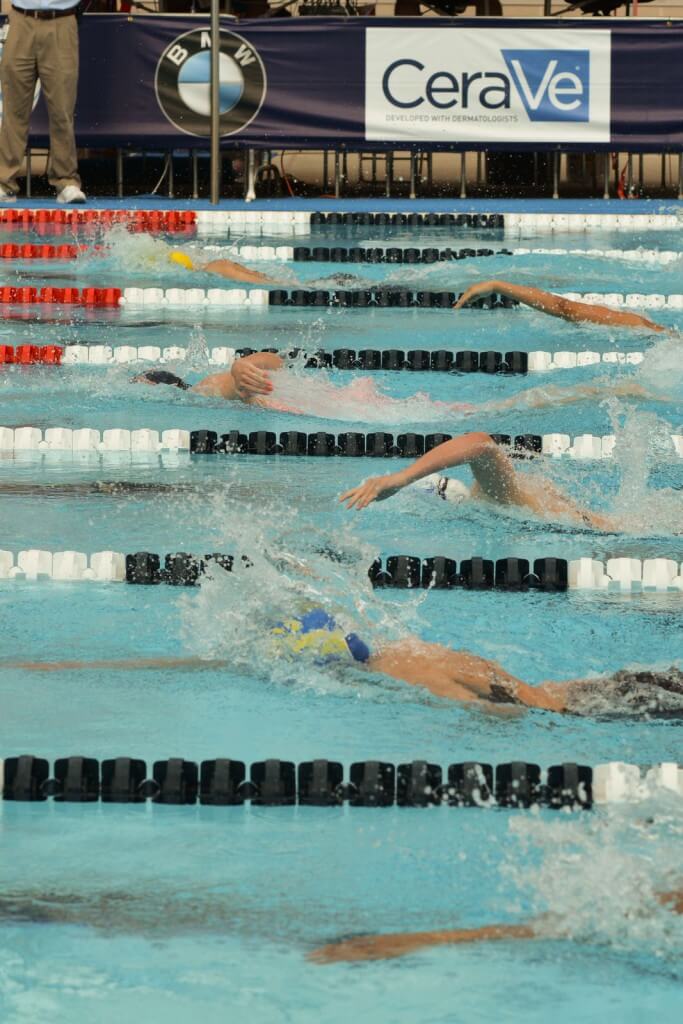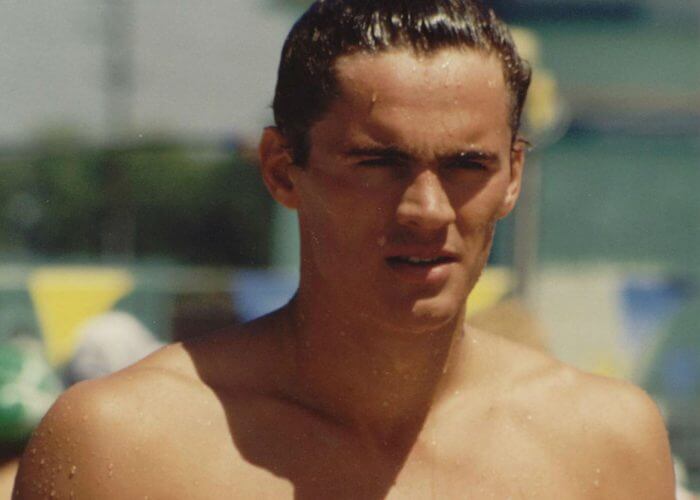Swimming Technique vs Swimming Style

Swimming Technique vs Swimming Style
By Wayne Goldsmith
Imagine you’ve never seen anyone swim before.
You’ve gone to the beach and you’ve seen dolphins play in the waves.
You’ve visited an aquarium and watched the fish cruise through the water effortlessly.
You’ve been on a “whale-watching” cruise on holidays and marveled at the ease and grace of these great mammals as they seem to glide without effort through the surf and swell.
You’ve seen other creatures on the “Discovery Channel” – penguins, otters, sea lions – swimming underwater with relaxed, easy, flowing movements – they almost seem to be flying through the water like birds.
But you’ve never actually seen a human being swim and you’d like to give it go.
How would you go about it?
Let’s invent swimming from scratch, i.e. from the beginning with no prior knowledge or limitations!
How Would You Invent Swimming from Scratch?
It would appear that anything and everything that moves through the water does so without tension: they seem to flow with the water as if they are a natural part of it.
If we tried to define the effortless movements of fish and some mammals through the water, we’d come up with words like:
- Relaxed
- Rhythmic
- Effortless
- Easy
- Flowing
- Natural
These terms immediately jump to mind when we witness an aquatic creature move through water.
Yet, when most swimmers head to the pool, join a squad and become part of a swimming training group, the words that drive the philosophies of most programs are:
- Effort
- Time
- Pace
- Speed
- Kick
- Pull
- Catch
- Push off
Whilst learning the meaning and application of these swimming technical terms is important, in the long term, it is not what you do that really matters in the pool – it’s how you do it.
Right from the first stroke – before the first lap, every swimmer (and coach) needs to decide to learn how to swim easily, smoothly and effortlessly with a flowing, relaxed, rhythmic technique and not be in a rush to see who can swim the most laps in the least amount of time.
Swimming coaches have a saying about the typical age group swimmer…”they do their fast work too slow and their slow work too fast” – in other words, they come to the pool with the aim of doing as much as they can in the shortest possible time.
Whilst it is natural, understandable and tempting to focus on the number of laps swum and racking up as many miles in the pool as possible, your capacity to swim fast and easily over race distances will be more dependent on your understanding of swimming movement than it is on training volume completed.
This article will aim to discuss how the way you swim – developing your own unique swimming style – is critical – and that arguments over appropriate training volume (i.e. what you do) are secondary to the importance of how you do it.
500 Swimming programs…What have I learned?
Having visited over 500 (yes – that’s five hundred) swimming programs around the world in the past 25 years, the only pattern to swimming training philosophies is that there is no pattern to swimming training philosophies.
I’ve been to highly successful college swimming programs in the USA where long, hard, aerobic training is the order of the day.
And I’ve been to other USA college swimming programs where the focus is on speed, explosiveness, technique, gym training and power – and they’ve also experienced success at the highest level.
I’ve worked with coaches in the UK, Spain, Germany, South Korea, Canada, Japan, South Africa, and New Zealand and in every capital city in Australia and the “what” of training – i.e. the content of workouts, the philosophy on training volume, the variations in how much kick to do, how much pull, how many training sessions etc. etc. – is incredibly variable and very different from program to program – coach to coach.
Over the past year for example, working with world class and Olympic level coaches and swimmers on deck in four continents and all training for similar events, I can report that the variations in average weekly training volume are considerable.
Some coaches are delivering world class results with as little as 20 miles (or even less) per week.
Others – also training swimmers to perform at the highest level – are driving programs which average 50-60 miles (or even more) per week.
That’s a 30 miles per week variation in average swimming training volume and yet the athletes themselves training in these philosophically different programs finish within a fraction of a second of each other when they race in competition.
Clearly – there is no one common way – no consistent method – no one size fits all training philosophy for training all swimmers.
All Different But All the Same.
There are some common factors present in all the best programs and some consistent technical qualities observed in all great swimmers including:
- They are relaxed in the water;
- They focus on flowing through the water rather than “muscling” the movements;
- They breathe deeply and smoothly;
- They are committed to improve skills like dives, starts, turns and finishes;
- They are comfortable swimming slowly – at intensity levels less than 70% of maximum and working on easy, relaxed movements;
- They work on developing real speed – but again with relaxed, easy, flowing movements;
- Recovery” means “recovery” – i.e. when they recover in their stroke, they aim to fully relax and keep their hand entry smooth and soft.
- The bottom line is – training volume isn’t everything.
It’s not a game of comparing “my training to your training” – more miles do not make better swimmers – unless those miles are completed with a focus on developing the simple technical qualities that underpin all successful swimming strokes.
The Myth of Movement: Don’t Waste time Developing the “Perfect” Technique.
Too many swimmers and coaches waste time and energy trying to develop the “perfect” swimming technique.
They’ve seen Michael Phelps on TV, marveled at the way he swims and decided – “I need to look like that”.
Forget it.
In the first place – there is no one perfect technique for all swimmers, of all ages and all levels of ability and experience.
Secondly, there’s a huge difference between Technique and Style.
Technique is a checklist of simple things that are common in all good swimming strokes – whereas Style is unique to the individual swimmer – it’s the unique way their body finds to move efficiently and effectively through the water.
Thirdly – believe it or not – Michael Phelps’ technique is NOT perfect………neither is the technique of most of the greatest swimmers of all time but……..IT’S PERFECT FOR HIM.
No one can swim like anyone else – that’s their Swimming Style.
However, everyone can learn the basics of efficient swimming Technique and train to apply the principles of efficient technique to their own unique Swimming Style.
The Alexander Popov Swimming Style Story – The Biggest Mistake I’ve Made in Swimming.

Some years ago, I had the great opportunity to walk and up down the deck at the Australian Institute of Sport pool for many years watching the great freestyle sprinter – former World Record holder, World Champion and multiple Olympic Gold Medalist Alexander Popov swim.
His coach – Gennadi Touretski had been recruited by Swimming Australia’s Head Coach Don Talbot to help change the philosophy of sprint swimming development in Australia.
Gennadi would occasionally invite me to walk and talk while Popov was training and I remember those days as some of the most enjoyable of my swimming career.
I became a “Popov” fan and felt that his smooth, easy, flowing, relaxed technique at high speed was THE way to go – that every swimmer in the world should be swimming like he was. So I watched and studied and tried to learn as much as I could observing this great sprinter for hours and hours.
I was also working with Swimming Australia at the time and was traveling around the country talking to coaches and swimmers about technique….AND naturally enough I tried to teach everyone I met the Popov stroke, the Popov drills, the Popov timing and Popov sprinting technique – because I was convinced it was the only way to go!
The problem I soon found out was this….Popov was the only one who could swim like Popov. It wasn’t just his Technique…it was his own unique SWIMMING STYLE that made him so successful and it was next to impossible to teach anyone else to do it his way.
So What’s Good Technique? And Why is it Different to Swimming Style?
The fundamentals of good technique in swimming include such simple concepts as:
- Be aware of the importance of the relationship between the head and the hips – aim to swim in a relatively “neutral” body position, i.e. “walking posture”;
- Keep your hands soft and your feet loose and relaxed;
- Inhale fully and exhale completely – never hold your breath when swimming – because holding your breath creates tension and tension is the enemy of swimming efficiency;
- “Catch” the water early by keeping your arm and elbow close to the surface – then press lightly and smoothly with your finger tips and wrist to commence the catch;
- Arm movements should start smooth and slow and accelerate throughout the movement;
- Stay relaxed and easy on recovery, i.e. every time your hands are moving forward in swimming it’s called “recovery”.
So that’s a checklist of what could be called “Technique”.
Swimming Style on the other hand is what you do – it’s a swimmer’s own unique, individual method of figuring out a way to move through the water.
A swimmer’s own swimming style will be based on a number of factors including strength, limb-length, core-stability, flexibility, mobility, and proportionality, e.g. length of their upper arm to their lower arm and a range of other things.
Allow the swimmer to develop their own swimming style while staying focused on the learning and mastery of the fundamental principles of good technique.
If you find that the swimmer’s capacity to develop an efficient swimming technique is somehow restricted by a physical limitation, e.g. shoulder flexibility, core-stability, then work on those specific issues and help them to overcome the limitation.
However, the aim should be on consistently striving to develop a swimming stroke that is right for each individual swimmer rather than trying to teach all swimmers to swim with a “one-size-fits-all” mythical biomechanically perfect swimming stroke.
Summary:
- If you had to invent swimming for human beings – having never actually seen a human being swim – but modeled it on how aquatic creatures move through water, you’d likely take a very different approach to the one most coaches and swimmers apply now;
- Focus on moving through water easily and effortlessly – with relaxation and with smooth, soft, controlled movements. The laps can come later! Trying to force efficiency by doing more laps than anyone else is not going to lead you to the swimming competition results you are seeking;
- Don’t be obsessed with the little things. There is no one perfect technical model for all swimmers. There is no perfect “hand pitch angle” for hand entry. There’s no one perfect head position that’s right for every swimmer. Learn the basic, fundamental concepts of efficient movement through water, practice them consistently and allow the swimmer to develop their unique swimming style;
- Swimming programs are very different around the world – particularly when it comes to philosophies around training volume. However – the things that lead to success are the same everywhere great swimming is practiced;
- If it works for you – then it works for you.
Wayne Goldsmith
www.wgcoaching.com
SKYPE: waynemoregoldsmith
Email: wayne@moregold.com.au
Mobile: +61 414 712 074
All commentaries are the opinion of the author and do not necessarily reflect the views of Swimming World Magazine nor its staff.





I think the perfect program is half the week traditional and the other half the Michael Andrews way. My kids are still very young so I have not tried this balance of conflicting philosophies yet??
Charlie Hopkin
Caleb Ryan
Thank you Wayne- once again you have us thinking and rethinking swimming.
At the Olympic camp in Atlanta many of the USA Olympic swimmers went over to the Georgia Aquarium, even some swam in the Big tank– many commented on how “one whip of the tail” would move the fish (or my favorite sea otter) and accelerate with amazing ease….!
I’d add– loving being in the Water. Ryan and my College buddy- Rowdy love to be in the water.
Let’s go!
Great text!
Hannes Jordaan
I agree that style is unique, but there is always room to improve technique, especially if a swimmer is trying hard but has had no formal training. Bad habits should not be encouraged or simply regarded as being one’s “style”. Sometimes a swimmer has to find what works for him or her in the end, however, so I fundamentally agree with this article’s premise.
Congrats for the article